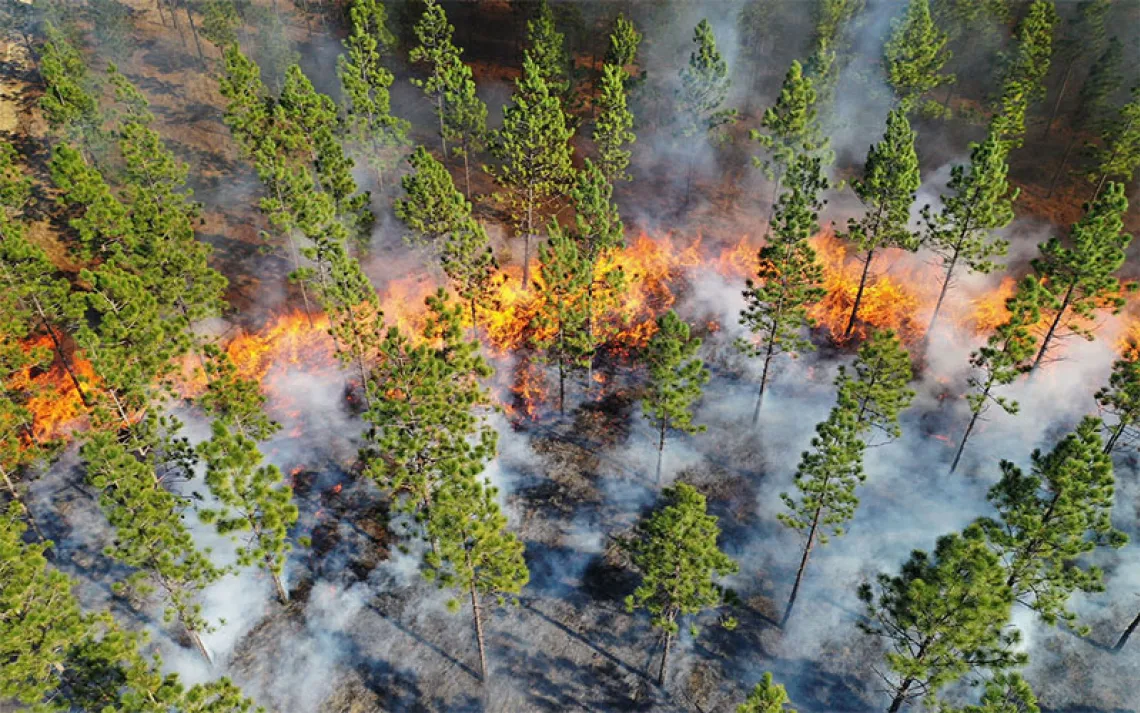Let It Flow
A coalition for eco-justice fights the U.S. Army Corps of Engineers’ plan to destroy Mississippi River wetlands

Big Oak Tree State Park. | Courtesy of the United States Fish and Wildlife Service
Across Missouri’s southeast corner stretch 133,000 acres of Mississippi River floodplain. When the river is high, up to 75,000 of these acres flood, creating crucial habitat for wildlife and absorbing floodwaters from towns up and down the river. This is the New Madrid Floodway, a federally designated area larger than Washington, D.C., that accommodates the natural pulses of the Mississippi River. It is “unique and irreplaceable” habitat, according to the U.S. Department of the Interior, supporting an “extremely diverse fishery” as well as “essential breeding and migration areas for 193 species of migratory birds,” including the endangered least tern. The National Wildlife Federation calls the floodway “the most important backwater fisheries habitat in the middle Mississippi River.”
But these wetlands are at risk. The U.S. Army Corps of Engineers wants to build a levee that would close the New Madrid Floodway off from the Mississippi, destroying the fishery and draining over 50,000 acres of the wetlands, in order to appease a small group of landowners who farm there.
Kevin Mainord, mayor of East Prairie, Missouri, farms about 10,000 acres within the floodway. He’s frustrated by the regular damage the seasonal backwater flooding does to his crops. “We’ve been left subject to that backwater flooding from the river for 70-odd years,” he says. “I don’t think our farmers should undergo investing in a crop every year, to have that crop—their capital—at risk from something that we can prevent.”
Landowners like Mainord have opposed the floodway since its creation. Back in 1928, after a catastrophic flood, the Corps designed it as part of the Mississippi Rivers and Tributaries Project, a massive control system throughout the lower Mississippi River valley. They built a 56-mile-long frontline levee along the river from Birds Point to New Madrid, Missouri, accompanied by a 36-mile-long setback levee, erected 3 to 10 miles inland. The enclosed land became designated floodway—land set aside to absorb waters during major flood events. The Corps left an intentional 1500-foot gap in the levee at New Madrid to allow drainage of rainwater from inside the floodway and provide room for the river to spread out when it’s high. In the 1930s, the government paid landowners for the flowage rights, but still they protested. One sued, but the case was dismissed. Some 3,000 armed themselves against Corps engineers in 1937 during another massive flood, and Missouri had to call in the national guard.
Eventually, the Corps allowed a concession. In 1954, it proposed closing the gap at New Madrid, and Congress authorized the plan. But its implementation has moved forward only in fits and starts, due mainly to disputes over the specifics of the plan. Meanwhile, the National Wildlife Federation and other environmental advocacy organizations have battled the Corps, commenting extensively on its draft environmental impact statements and even filing suit in federal court. They, along with the Environmental Defense Fund, won a decisive victory in 2007, when a federal judge ruled against the Corps, ordering a halt to all construction on the levee and the dismantling of $7 million worth of work already completed.
Those opposing the New Madrid levee hoped that ruling would bring an end to the project, but the Corps’s proposal has found new life since then, despite its serious flaws. “It’s an old-style, old-thought-process project,” says Melissa Samet, senior water resources counsel for the National Wildlife Federation. “One of the worst of the worst.” Not only would it sever Missouri’s last remaining connection between the lower Mississippi and its historic floodplain, destroy an essential fishery, and drain irreplaceable habitat for waterfowl and migratory birds who travel the Mississippi River flyway, but it would also endanger low-income and minority families up and down the river by increasing the risk of catastrophic flooding. In an era of climate change, Samet says, when flooding is on the rise, we need more floodplain, not less. And the project would cost taxpayers an estimated $165 million, all for the benefit of a small number of landowners. Finally, building the levee would encourage intensified agricultural development within the floodway, which would in turn discourage the Corps from using the floodway when necessary.
The Corps has already demonstrated a reluctance to operate the floodway. In 2011, they waited until the floodwaters at the confluence of the Ohio and the Mississippi Rivers registered 61.7 feet—eight inches above the mandated maximum level—before blowing a hole in the Birds Point levee. The delay came in part because the state of Missouri filed an emergency appeal that was denied by the U.S. Supreme Court. Meanwhile, the poor, predominantly African-American town of Cairo north of the levee flooded, and 2,800 of its citizens had to be evacuated. Total damage in Illinois reached into the millions. When the Corps finally blew a hole in the levee, the river at Cairo dropped a foot in 6 hours and 2.7 feet in 48 hours. “That’s a lot of water,” Samet says.
“To wait that long,” says Brad Walker, Big Rivers director of the Missouri Coalition for the Environment, “and to put everybody else in threat by delaying the activation of the floodway that is designed to protect them—that’s a completely irrational process.” Walker, an engineer by training, would like to see an alternative plan put in place—one that keeps the gap open and lowers the frontline levee of the floodway by six feet, allowing for a natural overtopping during flood events. That way, Walker argues, “There would be no human decision. The river would make the decision.”
But first, the New Madrid levee needs to be stopped. A coalition of over 90 environmental and civil rights advocacy organizations—including the National Wildlife Federation, the Illinois and Missouri Conferences of the NAACP, and the Sierra Club—are working to get the EPA to veto the project once and for all by educating members of Congress and the Obama administration, local community leaders, and the general public. They’re supported by more than 30 political and community leaders, including Illinois senators Dick Durbin and Mark Kirk and over 20,000 citizens.
Given that the EPA itself has rated the project as Environmentally Unsatisfactory, stopping it might seem like a straightforward task. But the Corps has a history of pushing through flawed projects, and their proposal has its supporters—including Missouri senator Roy Blunt. So the coalition continues its efforts while waiting for the Corps to submit its final environmental impact statement, in which it must address the myriad concerns raised by conservationists, other federal agencies, the Corps’s own independent review panel, outside experts, and even its own leadership, who has called the project “an economic dud” with “huge environmental consequences.” The coalition has been waiting for this final EIS since 2013.
“It’s difficult to understand how they could address the concerns that have been raised without starting over from scratch,” says Samet. “There have been so many basic, fundamental flaws highlighted. It must [be taking] them a long time to figure out what to say.”
WHAT YOU CAN DO
Sign the National Wildlife Federation’s petition and tell the EPA to veto the New Madrid levee.
 The Magazine of The Sierra Club
The Magazine of The Sierra Club



